
The Scrophulariaceae are a family of flowering plants, commonly known as the figwort family. The plants are annual and perennial herbs, as well as one genus of shrubs. Flowers have bilateral (zygomorphic) or rarely radial (actinomorphic) symmetry. The Scrophulariaceae have a cosmopolitan distribution, with the majority found in temperate areas, including tropical mountains. The family name is based on the name of the included genus Scrophularia L.
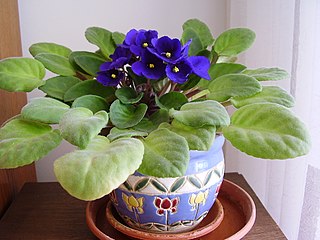
Gesneriaceae, the gesneriad family, is a family of flowering plants consisting of about 152 genera and ca. 3,540 species in the Old World and New World (Gesnerioideae) tropics and subtropics, with a very small number extending to temperate areas. Many species have colorful and showy flowers and are cultivated as ornamental plants.

Haemodoraceae is a family of perennial herbaceous flowering plants with 14 genera and 102 known species. It is sometimes known as the "bloodwort family". Primarily a Southern Hemisphere family, they are found in South Africa, Australia and New Guinea, and in the Americas. Perhaps the best known are the widely cultivated and unusual kangaroo paws from Australia, of the two closely related genera Anigozanthos and Macropidia.
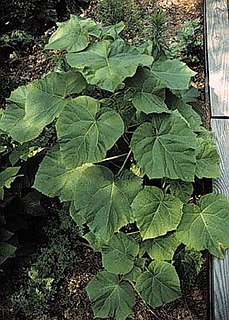
Paulowniaceae are a family of flowering plants within the Lamiales. They are a monophyletic and monogeneric family of trees with currently 7 confirmed species. They were formerly placed within Scrophulariaceae sensu lato, or as a segregate of the Bignoniaceae.
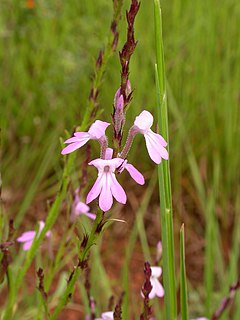
Orobanchaceae, the broomrapes, is a family of mostly parasitic plants of the order Lamiales, with about 90 genera and more than 2000 species. Many of these genera were formerly included in the family Scrophulariaceae sensu lato. With its new circumscription, Orobanchaceae forms a distinct, monophyletic family. From a phylogenetic perspective, it is defined as the largest crown clade containing Orobanche major and relatives, but neither Paulownia tomentosa nor Phryma leptostachya nor Mazus japonicus.
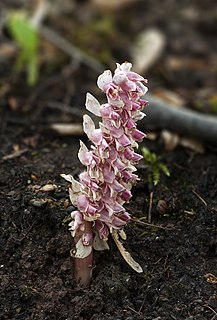
Lathraea squamaria, the common toothwort, is a species of flowering plant in the family Orobanchaceae. It is widely distributed in Europe and also occurs in Turkey.

Melampyrum is a genus of about 20 species of herbaceous flowering plants in the family Orobanchaceae known commonly as cow wheat. They are native to temperate regions of the Northern Hemisphere. They are hemiparasites on other plants, obtaining water and nutrients from host plants, though they are able to survive on their own without parasitising other plants.
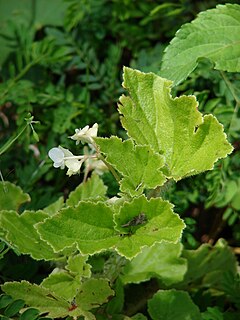
Begoniaceae is a family of flowering plants with two genera and about 1825 species occurring in the subtropics and tropics of both the New World and Old World. All but one of the species are in the genus Begonia. There have been many recent discoveries of species in the genus Begonia, such as Begonia truncatifolia which is endemic to San Vincente, Palawan. B. truncatifolia is smaller in size than other species of the genus Begonia and this new species is proposed Critically Endangered by standards set by the IUCN. The only other genus in the family, Hillebrandia, is endemic to the Hawaiian Islands and has a single species. Phylogenetic work supports Hillebrandia as the sister taxon to the rest of the family. The genus Symbegonia was reduced to a section of Begonia in 2003, as molecular phylogenies had shown it to be derived from within that genus. Members of the genus Begonia are well-known and popular houseplants.

A parasitic plant is a plant that derives some or all of its nutritional requirement from another living plant. They make up about 1% of angiosperms and are found in almost every biome. All parasitic plants have modified roots, called haustoria, which penetrate the host plant, connecting them to the conductive system – either the xylem, the phloem, or both. For example, plants like Striga or Rhinanthus connect only to the xylem, via xylem bridges (xylem-feeding). Alternately, plants like Cuscuta and Orobanche connect only to the phloem of the host (phloem-feeding). This provides them with the ability to extract water and nutrients from the host. Parasitic plants are classified depending as to the location where the parasitic plant latches onto the host and the amount of nutrients it requires. Some parasitic plants are able to locate their host plants by detecting chemicals in the air or soil given off by host shoots or roots, respectively. About 4,500 species of parasitic plant in approximately 20 families of flowering plants are known.

The orange-breasted sunbird is the only member of the bird genus Anthobaphes; however, it is sometimes placed in the genus Nectarinia. This sunbird is endemic to the fynbos habitat of southwestern South Africa. They are sexually dimorphic with females being olive green while the males are orange to yellow on the underside with bright green, blue and purple on the head and neck.
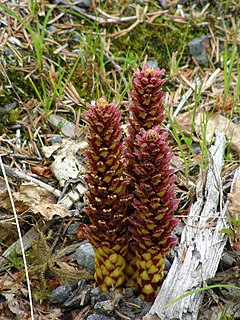
Boschniakia is a genus of parasitic plants in the family Orobanchaceae. They are known commonly as groundcones and they are native to western North America and extreme northeastern Asia. Some taxonomists consider Boschniakia to be three separate genera: Boschniakia, Kopsiopsis, and Xylanche. When the genus is split, only a single species remains: Boschniakia rossica, the northern groundcone.

Kopsiopsis hookeri is a species of parasitic plant in the family Orobanchaceae known by as Vancouver groundcone or small groundcone.
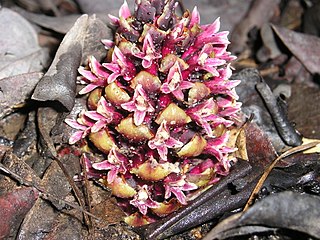
Kopsiopsis strobilacea, the California groundcone, is a species of parasitic plant in the family Orobanchaceae. It is native to California and southern Oregon, where it grows in wooded areas and chaparral. It is a parasite of manzanitas and madrones, which it parasitizes by penetrating them with haustoria to tap nutrients. The groundcone is visible aboveground as a dark purplish or reddish to brown inflorescence up to 18 cm (7.1 in) long. Pale-margined purple flowers emerge from between the overlapping bracts.

Harveya purpurea is an annual herb with large, showy flowers and scale-like leaves, parasitic on the roots of shrubs and trees, endemic to South Africa in the Eastern and Western Cape. It occurs from the Cederberg to the Cape Peninsula, and along the coastal belt to Grahamstown in the Eastern Cape, mainly among fynbos, on stony slopes and sandy flats.

Rhinantheae is a tribe with less than 20 genera of herbaceous plants in the family Orobanchaceae.

Hedbergia decurva, formerly Bartsia decurva, is a species of flowering plants in the family Orobanchaceae.
Hedbergia longiflora, formerly Bartsia longiflora, is a species of flowering plants in the family Orobanchaceae.
Bartsiella is a monotypic genus of flowering plants, initially classified in Scrophulariaceae, and now within the broomrape family Orobanchaceae. It contains a unique species, Bartsiella rameauana.
Xylanche himalaica is a species of flowering plant in the family Orobanchaceae native to Asia. It was first formally named as Boschniakia himalaica in 1884 and transferred to the genus Xylanche in 1893. It is the only species in the genus Xylanche.
















